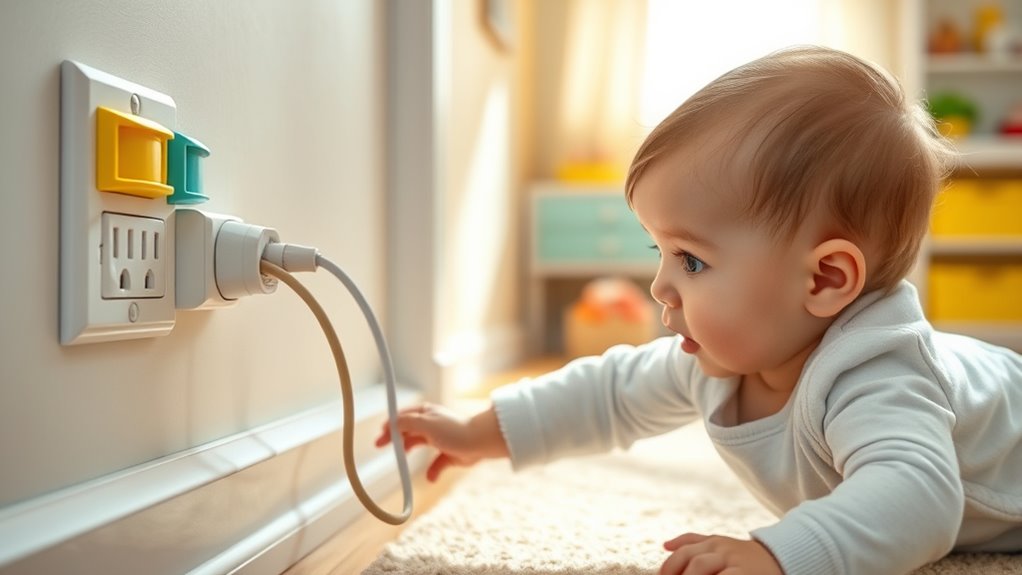To keep your curious toddler safe at home, start by inspecting each room for hazards like sharp objects, loose wiring, and unattended flames. Secure furniture and heavy items to prevent tipping, and install outlet covers and cord organizers to avoid electrical hazards. Make kitchens and bathrooms safer with locks and anti-scald devices. Setting up safety gates and designated play zones helps keep exploration fun yet secure. Keep dangerous items out of reach—continue for more tips to create a safer environment.
Key Takeaways
- Regularly inspect and eliminate home hazards like sharp objects, loose wiring, and fire risks to prevent accidents.
- Secure furniture, heavy appliances, and cords with anchors and covers to prevent tipping and strangulation.
- Install childproof outlet covers, organize cords, and unplug devices when not in use to prevent electrical shocks.
- Use safety gates, barriers, and designated play areas to keep toddlers away from stairs, kitchens, and other dangers.
- Implement safety measures in kitchens and bathrooms, such as cabinet latches, anti-scald devices, and non-slip mats.
Assessing Potential Hazards in Your Home

Before bringing a toddler into your home, it’s vital to identify and address potential hazards. Start by inspecting areas where fire hazards could exist, such as unplugged outlets, loose wiring, or unattended flames. Ensure smoke detectors are working and fire extinguishers are accessible. Water safety is equally important—covering pools, securing buckets, and checking bathroom fixtures prevents accidental drownings. Keep cords, small objects, and sharp items out of reach, and consider barriers for kitchens and bathrooms. Walk through each room, imagining how your toddler might explore or get hurt. By proactively recognizing fire hazards and water safety risks, you create a safer environment that minimizes dangers and gives you peace of mind as your little one begins to discover the world around them. Incorporating safety measures and staying updated on industry trends can help you stay informed about the latest safety products and practices. Additionally, understanding how AI in Business impacts safety technology can lead to more innovative and effective home safety solutions. Being aware of home safety technologies can further enhance your efforts to protect your child. Recognizing the importance of local resources, such as community safety programs, can also support your ongoing safety efforts.
Securing Furniture and Heavy Items

Securing furniture and heavy items is essential because toddlers are naturally curious and can easily tip or pull over unstable pieces. Ensuring furniture stability and heavy object anchoring prevents accidents and injuries. To effectively toddler-proof your home, focus on these key steps:
Securing furniture and heavy items prevents accidents caused by curious toddlers pulling or tipping objects.
- Use wall straps or brackets to anchor large furniture such as bookshelves, dressers, and cabinets.
- Secure heavy appliances and electronics to prevent tipping if pulled or pushed.
- Regularly check the stability of furniture and re-anchoring as needed, especially after rearranging or heavy use. Floating on water techniques like anchoring or stabilizing objects can also be applied to ensure safety.
Managing Electrical Outlets and Cords

You should start by installing outlet covers and plates to prevent your toddler from sticking fingers or objects inside. Managing cords with clips or ties keeps them organized and reduces tripping hazards. Additionally, keeping cords hidden behind furniture makes your space safer and less tempting for curious little ones. Using cord management techniques can further minimize the risk of accidents and maintain a tidy environment. Proper outlet safety measures are essential to prevent electrical hazards as part of your overall toddler-proofing strategy. Incorporating electrical safety practices helps protect your child from potential shocks or injuries. Being aware of anime movies and their themes can also inspire you to create a safe and engaging environment at home. For example, understanding Glycolic Acid benefits can guide you in choosing gentle skincare products that are safe around children when properly stored.
Outlet Covers and Plates
Electrical outlets and cords pose significant safety risks for curious toddlers, making it essential to install outlet covers and plates. These simple additions help prevent accidental shocks and insertions that compromise electrical outlet safety. When choosing outlet cover options, consider the following:
- Childproof Outlet Covers – These secure plugs prevent toddlers from inserting objects into outlets.
- Sliding Outlet Plates – These plates stay flush with the wall but slide open when you need access, maintaining safety while allowing functionality.
- Tamper-Resistant Outlets – Built-in safety shutters block foreign objects, offering an extra layer of protection.
- Understanding electrical safety can help you select the most effective childproofing solutions for your home.
Cord Management Strategies
To keep your toddler safe around outlets and cords, managing their placement and visibility is key. Use a wire organizer to neatly bundle cords together, reducing clutter and preventing choking hazards. Secure loose cords along furniture or walls with cord concealment solutions like adhesive clips or cord covers, keeping them out of your toddler’s reach. Avoid leaving cords hanging or dangling, as curious hands may tug and cause injury or fall. Regularly check cords and outlets for damage or loose connections, replacing or repairing as needed. Additionally, implementing privacy policies can help protect your family’s data when researching safety products online. Proper cord management techniques also include unplugging devices when not in use to prevent accidental shocks. Incorporating childproofing measures such as outlet covers and cord shorteners further enhances safety. Understanding parental guidance and adhering to safety recommendations helps foster a secure space for your child’s growth and curiosity. Using electric safety standards can further reduce risks associated with electrical cords and outlets. By organizing wires and concealing cords effectively, you minimize the chances of your toddler pulling on or playing with electrical wires, creating a safer environment as they explore your home.
Keeping Cords Hidden
Keeping cords out of sight is an essential step in toddler-proofing your home. Proper cord concealment reduces the risk of accidental pulling, choking, or tripping hazards. To enhance cord safety, consider these strategies:
- Use cord covers or sleeves to hide electrical cords along baseboards or walls, preventing curious hands from tugging.
- Install outlet covers that block access to electrical outlets, reducing the chance of electric shock.
- Secure excess cord length out of reach with cable clips or hooks, keeping cords neat and preventing tripping.
- Select child-safe electrical products that are designed to minimize hazards and withstand curious exploration.
- Be mindful of environmental considerations, such as ensuring cords are properly secured to prevent damage and reduce clutter hazards.
Creating Safe Kitchen and Bathroom Spaces

Creating a safe kitchen and bathroom for your toddler involves proactive measures to prevent accidents and injuries. You should child proofing drawers to prevent your toddler from accessing sharp utensils or dangerous objects. In the bathroom, implement sink safety measures, like installing anti-scald devices and using non-slip mats. Use the following table to highlight key safety tips:
| Safety Measure | Purpose |
|---|---|
| Child proofing drawers | Prevent access to knives and small items |
| Sink safety measures | Avoid burns and slips |
| Outlet covers | Prevent electrical shock |
| Non-slip mats | Reduce slipping hazards |
Additionally, fostering a creative practice at home can help you develop innovative solutions for safety challenges. Incorporating child safety awareness into daily routines can further reinforce safe habits and reduce potential hazards. Engaging in regular home safety assessments ensures that your environment adapts to your toddler’s growing curiosity and abilities.
Storing Dangerous Items Out of Reach

Since toddlers are naturally curious and quick to explore, it’s essential to store dangerous items out of their reach. Using childproofing essentials helps prevent accidents and guarantees safety. For effective dangerous item storage, consider these key areas:
- Medications and vitamins – keep in high cabinets with childproof locks to prevent accidental ingestion.
- Cleaning supplies – store in locked closets, away from curious hands.
- Sharp objects and tools – place in secure drawers or cabinets with safety latches.
Installing Safety Gates and Barriers

Installing safety gates and barriers is one of the most effective ways to keep your toddler safe around stairs and other hazardous areas. When installing safety gates, guarantee they fit securely and are made from sturdy materials. Choose barriers with a reliable locking mechanism that your toddler can’t open but that’s easy for you to operate. Consider the gate’s height and whether it extends enough to block doorways or staircases completely. When choosing barriers, look for those certified for safety standards and suitable for your home’s layout. Proper installation is key; follow manufacturer instructions carefully and check the gate regularly for stability. By selecting the right barriers and installing them correctly, you create a safer environment where your curious toddler can explore with fewer risks.
Encouraging Safe Play and Exploration

You can foster safe play by setting up designated areas where your toddler can explore freely. Using age-appropriate toys keeps them engaged while minimizing risks. Remember to supervise their activities to guarantee they stay safe while discovering new things.
Set Up Play Zones
Creating designated play zones is essential for encouraging safe exploration while giving your toddler the freedom to discover. By setting up specific areas, you control the environment, making it safer and more engaging. Use child proof furniture to create boundaries and prevent accidents. Incorporate safe toy storage to keep the area organized and reduce hazards. To enhance the space:
- Choose a corner or room with soft flooring for comfort.
- Arrange child proof furniture to block off dangerous areas.
- Designate a storage bin for toys to promote tidiness and safety.
These steps help foster independence while minimizing risks. Keeping play zones well-organized ensures your toddler can explore freely without constant supervision, making both your life and theirs more enjoyable. Proper setup transforms your home into a safe haven for curiosity and growth.
Use Age-Appropriate Toys
Using age-appropriate toys is key to fostering safe play and exploration for your toddler. These toys are designed to match your child’s developmental stage, reducing choking hazards and unsafe parts. When selecting age appropriate toys, look for labels indicating safety standards and avoid small, loose pieces that could be swallowed. Keep your child’s toys organized in safe toy storage areas, which makes it easier to supervise play and prevents clutter that could cause trips or falls. Regularly inspect toys for damage, and remove broken or worn items immediately. By choosing suitable toys and maintaining a tidy play space, you create an environment that encourages curiosity while minimizing risks, helping your toddler explore confidently and safely at home.
Encourage Supervised Exploration
Supervised exploration allows your toddler to learn and develop confidence while staying safe. By providing a safe environment with toddler-friendly furniture and appealing nursery decor, you encourage curiosity without risk. To enhance safe exploration, consider these steps:
- Set clear boundaries with gates or barriers around hazardous areas, ensuring they blend with your nursery decor.
- Offer age-appropriate toys and materials that promote discovery while preventing choking hazards.
- Regularly supervise your child during play, remaining attentive to their interactions with furniture and surroundings.
Creating a space that invites exploration while maintaining safety helps your toddler build independence. With thoughtfully chosen nursery decor and sturdy toddler-friendly furniture, you foster confidence and curiosity, making exploration both fun and secure.
Frequently Asked Questions
When Should I Start Toddler-Proofing My Home?
You should start toddler-proofing your home as soon as your little one begins to crawl or explore beyond their usual play area. Create a childproofing checklist, including safety gate installation at stairs and doorways. Kids can get into things quickly, so early preparation helps prevent accidents. By proactively childproofing, you keep your curious toddler safe and give yourself peace of mind as they grow more mobile and adventurous.
How Often Should I Review Safety Measures?
Think of safety measures as a garden needing regular tending—you wouldn’t water your plants once and forget, right? You should review household hazards and update your safety checklists monthly or whenever your toddler reaches a new developmental stage. Kids explore constantly, so frequent reviews help catch new hazards, ensuring your home remains a safe space. Regular check-ins keep your safety efforts fresh and effective.
Are There Specific Safety Products Recommended for Toddlers?
When choosing safety products for your toddler, you should look for trusted options like child-proof locks and outlet covers. These products help prevent accidents and keep your little one safe while exploring. Make sure to install child-proof locks on cabinets and drawers, and use outlet covers to block electrical outlets. Regularly check that these safety items are in place and functioning properly to guarantee continuous protection for your curious toddler.
How Can I Make My Home More Toddler-Proof Temporarily?
Imagine a sudden, unexpected mess or a dangerous discovery—your home’s safety hinges on quick action. To make your space more toddler-proof temporarily, follow a child proofing checklist and implement toddler safety tips like securing furniture, removing choking hazards, and installing safety gates. Act swiftly to create a safer environment, so your curious explorer can play freely without risking injury. Stay alert—your vigilant steps make all the difference.
What Signs Indicate My Toddler Has Accessed a Hazardous Item?
You should watch for signs of hazard recognition, like unusual smudges, misplaced items, or open containers, which suggest your toddler accessed hazardous items. Safety signs, such as torn packaging or spilled substances, also indicate potential danger. Regularly check your home for these clues, and stay vigilant. If you notice any, act quickly to remove the hazard and guarantee your child’s safety.
Conclusion
By toddler-proofing your home, you’re building a safe harbor amid curious waves. Each secured outlet, gate, and hidden danger becomes a lighthouse guiding your little explorer’s journey. With every thoughtful step, you create a sanctuary where curiosity can flourish without harm. Remember, safety isn’t a one-time act but a steady rhythm—your ongoing song of protection and discovery. In this harmony, your child’s adventures bloom securely, rooted in love and vigilance.










